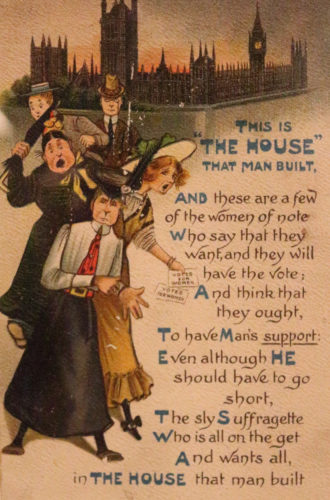Suffrage 125: Resisting The Triumph of Women’s Rights – Anti-Suffrage Anti-Utopias**
Utopian fiction of the nineteenth and early twentieth centuries became one literary space in which writers interested in social reform, including women’s suffrage and broader gender equality, found an outlet for imagining what a different world might look like. As I discussed in an earlier post, Catherine Helen Spence’s utopian A Week in the Future visualises a society premised on communal living and women’s equal involvement in public and private life, although not without some troubling aspects.

Anti Suffrage Postcards c.1908, People’s History Museum
Embedded in much utopian writing, however, is the ambivalence that one reader’s utopia may well be another’s dystopia, the ideals of an imagined community seeming constraining, prejudiced, or authoritarian. Much of this is made overt in the contemporary dystopia, with its focus on discriminatory, oppressive political and legal regimes—notably Orwell’s 1984 and Atwood’s The Handmaid’s Tale.
A different and now far-less-common approach can be seen in another aspect of the utopian genre, the anti-utopia. These are works that use a utopian form to satirise utopian values and aims to ‘denounce the irrelevance and inconsistency of utopian dreaming and the ruin of society it might entail’.[1] The anti-utopia provides an opportunity to describe an alternate, imagined community; in the case of the anti-suffrage anti-utopia, this parodic ideal represents the excesses, and social upheaval, that will result from women’s equality.
Millie Finkelstein’s The Newest Woman: The Destined Monarch of the World (1895)[2] and Tom Bracken’s The Triumph of Women’s Rights: A Prophetic Vision (1892)[3] are both anti-utopias that warn of social upheavals that will occur with women’s political and social equality. Anti-utopian writing here assumes a conservative role that reflects broader resistance to political and legal change, notably in the ‘inconsistency’ said to arise between women’s involvement in political life and ‘their’ domestic duties. These concerns can be seen in the objections raised by female opponents to the ‘Adult Suffrage Bill’ in their petition to the South Australian Parliament: the ‘divinely ordered’ distinction between men and women, whose ‘duties and life… are… to be different both in the State and in the home’, and the ‘present duties’ of women ‘from which men cannot relieve them’.[4] These are, as Susan Magarey puts it, a way of positing ‘quite distinct functions appropriate to each sex’,[5] and intertwine gender, biological sex, and an essentialist view of women’s possible social and political roles.
Bracken’s short pamphlet, The Triumph of Women’s Rights, takes place in the New Zealand Parliament after the election of its first female parliamentarians. Bracken, a New Zealand poet and politician,[6] depicts the new, feminised political order as a radical act, with New Zealand’s populace threatening revolution in order to secure a female Governor. Both Houses of the Parliament are now predominantly women, with the Legislative Council exclusively so. The bills proposed by the female parliamentarians speak to gendered interests, ranging from ‘The Purchase of Dolls Eyes and Crochet Cotton Bill’, to the ‘The Conversion of Natives of Central Africa Bill’, and reflect Bracken’s understanding of women’s priorities (the home and family, but also participation in a certain form of evangelical, missionary Christianity). The pamphlet ends with a depiction of some of the parliamentarians enjoying an evening’s symposium, where most of the members sing songs reflecting the new social order (notably about men at home caring for children), although a male member’s anti-suffrage song, written by Bracken himself, causes quite the stir.
Bracken’s satire is at times ambivalent, and there are moments that appear in favour of certain reforms. But throughout he expresses concern with women’s ability to participate in politics (apart from the bills put forward in parliament, the few remaining male members returned are ‘all good-looking young fellows’[7]), and change more generally (a new, scientific parliamentary prayer is now given to the ‘Electric Current’,[8] and there is an underlying unease throughout that women want not equality but superiority[9]). Most notably, Bracken returns repeatedly to men’s displacement from politics into the domestic sphere, caring for children while women work. The ‘triumph of women’s rights’ has, it seems, upset a number of institutions, and is undeniably political in consequence, but the most important change for Bracken is in the home.
In Finkelstein’s The Newest Woman, the upset created by women’s rights is similarly located in the political, but, again, is felt in the home and by the family. An incompetent government, coupled with an epidemic, has led to social and political revolution, with women now dominating politics and business, while men have ‘confined themselves strictly to private life’.[10]
Into this seeming utopia, set in Melbourne in 1950, come Randolph Parker and his daughters Charity and Pleasure. They have come to Melbourne seeking their wife and mother, Margaret, who, convinced by both her husband and another man of her and women’s superiority, has eloped, taking with her her youngest daughter Faith. To find Margaret and Faith, Charity joins the Salvation Army and visits the ‘wretched hovels’[11] and opium dens of Melbourne’s laneways; appropriately, Pleasure looks in high society, including at the theatre and Melbourne Cup. Faith is found first as a Melbourne Cup jockey, and then revealed to be the bushranger Kate Keely. Captured in a standoff in Glenrowan, Kate then escapes, stealing a train and dying in a subsequent crash.
The rest of the novel is similarly sensational; Randolph confronts his wife’s ‘seducer’ on a Melbourne theatre stage (the novel is at pains to tell us that nothing sexual occurred between Margaret and him), and then Randolph and Margaret die, intertwined, at sea while returning to England. The novel’s conclusion sees a restoration of the supposedly natural role of women, with both Charity and Pleasure married, ‘content to labour in the respective spheres to which Heaven had called them’.[12]
In her preface to the novel, Finkelstein underscores that ‘the advanced woman of the future, whose triumphs in both virtue and vice I seek to picture, does not enlist my personal sympathy’.[13] Certainly, the disruption depicted in the novel foretells of a future characterised by upheaval, prompted by the changing roles available to women. And yet, there are undoubtedly attractive aspects of the novel: the reference to Victoria as an ‘Adamless Eden’[14] is not, perhaps, entirely ironic, and possibly prompted Finkelstein’s defensive preface. Susan K Martin describes the novel as ‘yok[ing] together antithetical narrative objectives’,[15] and these disparate strands produce a work that, while avowedly conservative, can be read in multiple and potentially resistant ways by its audience.
As Julia Bush notes in her study of female anti-suffragism,[16] examining activism against women’s enfranchisement can tell us not only about anti-suffragism, but the political activities and choices made by suffrage activists as well, what they were responding to and reacting against. Anti-suffragism is part of the history of women’s suffrage, as we know full well in South Australia. After all, it was the attempt to derail the 1894 suffrage bill through the addition of a provision to enable women to stand for parliament[17]—a vision common to the anti-suffrage anti-utopia—that led to South Australian women’s eligibility for precisely this.
And so, anti-suffrage activism, including in literature, should not be too-readily dismissed purely for its conservatism and disconnect with contemporary ideas, but rather read and understood as an aspect of the complex history of women’s suffrage. As Bush notes and as we can see in both Finkelstein and Bracken, anti-suffrage campaigners spoke to common concerns about the social role of women, often within larger anxieties about this in a changing world, and some of these concerns overlapped with those of at least certain suffrage activists. Discussion about women’s roles can be seen in both conservative and progressive writing, and articulated in disparate ways in each. Both utopian and anti-utopian works give us a better understanding of how women’s rights and roles were culturally understood, and how it was imagined that these conflicts might, possibly, be resolved.
**I am very grateful to Prue McDonald of the State Library of South Australia for her assistance in researching this piece.
[1] Fátima Vieira. ‘The Concept of Utopia.’ The Cambridge Guide to Utopian Literature. Ed. Gregory Claeys. Cambridge University Press, 2010: 3-27, 16.
[2] Millie Finkelstein. The Newest Woman: The Destined Monarch of the World. Sportswoman, 1895.
[3] Tom Bracken. The Triumph of Women’s Rights: A Prophetic Vision. W McCullough, 1892.
[4] https://www.centreofdemocracy.sa.gov.au/collection/?details=1&irn=86&appid=1553577637
[5] Susan Magarey. ‘Sex vs Citizenship: Votes for Women in South Australia.’ Journal of the Historical Society of South Australia 21 (1993): 72, 74.
[6] See Paul Hunt, ‘Thomas Bracken, 1843-1898.’ Kōtare 7.3 (2008): 23-29, for a biography of Bracken.
[7] Bracken, 6.
[8] Ibid, 17.
[9] Ibid, 10
[10] Finkelstein, 11.
[11] Ibid, 16.
[12] Ibid 106.
[13] Ibid 2-3.
[14] Ibid 17.
[15] Susan K Martin. ‘The Newest Woman in a New World: Gender Anxiety and New Women in Turn-of-the-Century Australian Fiction.’ ACH 23 (2004): 121-136, 122.
[16] Julia Bush. Women Against the Vote: Female Anti-Suffragism in Britain. Oxford University Press, 2007, 5.
[17] Paul Sendziuk and Robert Fraser. A History of South Australia. Cambridge University Press 2018, 91; Bonnie Ramsay. ‘The Enfranchisement of Women in South Australia.’ Cabbages and Kings 22 (1994): 3-13, 12.





